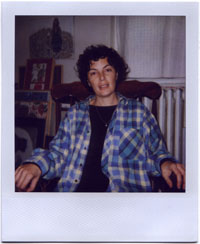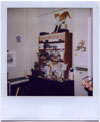 What
would you like to know? You can ask me the questions in advance, so that I have
time to think.
What
would you like to know? You can ask me the questions in advance, so that I have
time to think. Stela Lie
Stela Lie. Born 1956 in Timisoara. From 1990 on, assistant in graphics at the Art Academy in Bucharest.
 What
would you like to know? You can ask me the questions in advance, so that I have
time to think.
What
would you like to know? You can ask me the questions in advance, so that I have
time to think.
- I have two basic questions that I ask all the women I've met for interviews: Is there a context for contemporary art in Romania? And the second question: Have you felt some sort of pressure in the art circles and cultural institutions as a woman artist?
It's equally difficult for men and women to work in contemporary art in Romania. At the same time the men are lagging in their development. For instance, in my personal experience, they expect food on the table, and this food someone has to prepare it and put it on the table, and that is the woman. All this takes a lot of time, and that is time that could be put into our professional work. Yes, and here's my husband! Meet my husband! He is an architect, he's not stupid, a contemporary person, and in spite of it all he almost completely relies on me for homework. But all this is the women's fault, with the way they're educating their sons. For me it's always easier to speak out of personal experience, and not from a feminist or gender theoretical point of view. But what I can permit myself to say, generalizing the question: Society is always patriarchal. So much for my answer to your second question, does it do?
On the context for contemporary Romanian art, my answer to your first question.
If this can be called a context, the company or gang of Soros. There are some groups that are official, but I don't want to be part of them, and I cannot.
Both groups are extremists. In these groups or communities there is no place for people like Dan Perjovschi. In Soros there is no place for me, I work on painting on paper, I don't have the means to do more at this stage. I cannot imagine being part of the Soros clique, that would be in contradiction with my personal dignity as an artist and as a person. This is the reason why I started to organize exhibitions myself a few years ago. I started to work with some women artists, who are around 40 years old. At the beginning I was thinking that I could find support, be it only on a theoretical level, for our exhibitions. Since there is no money for catalogs or other printed matter, we make something like a catalog with photocopies. I find that documentation is very important in our work as artists, despite the difficulties we are facing in this direction. Most of our exhibitions are not represented well, or not represented at all in the press, in the mass media. These exhibitions, we make them with our own resources and efforts, which means that we work only with materials and technologies that we can spare from our personal budgets. I cannot say that I am friends with these women, but we just like working together. I prefer making exhibitions with people who don't play in the national league, but who are at the same time real professionals. This is a kind of reaction to the polarity, to the breaking up of the people who work in contemporary art into two poles. There are many artists like me in this situation. In the "B" team. Our exhibitions are for the medium-class artists.
- Stela, quite clearly and honestly, about the "B" team and the national league, maybe this comparison sounds a bit hooligan-like, but it represents so well this really existing polarisation in the circles of people working in contemporary art, with the mechanisms of control and the power relations within the system itself, or semblance of a system, in Bulgaria!
 This
expression about the national league comes from an exhibition in Boswil in 1995,
"Freshly Painted". I borrowed the expression from Bruno Landys, a
Swiss artist, and I liked it so much that from then on I've used it all the
time. In the following, we became closer with Bruno and made several exhibitions
together, the first of which was in Switzerland in 1996. We used the opportunity
to invite artists who are not at the top, whom the curators usually do not notice,
but who are in fact good and interesting authors.
This
expression about the national league comes from an exhibition in Boswil in 1995,
"Freshly Painted". I borrowed the expression from Bruno Landys, a
Swiss artist, and I liked it so much that from then on I've used it all the
time. In the following, we became closer with Bruno and made several exhibitions
together, the first of which was in Switzerland in 1996. We used the opportunity
to invite artists who are not at the top, whom the curators usually do not notice,
but who are in fact good and interesting authors.
I don't want you to misunderstand me, when I'm speaking about our exhibitions with women, the question is not only material things, but rather the lack of theory and good, real operative critique. When we make an exhibition the problem with the public is also one of the foremost. It's not only that people are not interested, but even if they come they do not ask meaningful questions. I explain this with the lack of an adequate visual culture. You see I myself teach at the Academy of Art, and frequently I ask myself: "What is happening to all those students in art history when they graduate?" It's been a sore lack to me that there is not a single adequate critic who is writing here in Romania. I recognize the problem of the lack of information, this is a fundamental question.
- But here in Romania four magazines are published on contemporary art, and they maintain quite a good level, or at least that's what it looks like from the outside. They publish important theoretical articles in Romanian translation, which should at least help to create some sort of critical discussion or improve the "climate" in the art circles?
Yes, that's true, but I cannot say that they are really accessible to the students, or even to a large part of the artists. Let me comment on their price, you see they are more expensive than the fashion magazines! How do you want people to buy them in this time of total crisis?! And even in those magazines they do not publish concrete and practical information that can be of concrete use to you in your professional life. In Romania, what is lacking most has always been and continues to be information! Here there is not even such a thing as the bulletin of the Bulgarian Artists' Union in Bulgaria. Not that they'd publish all that much information, but it's at least something in the context of a complete lack of it. And how many of my students or colleagues have a computer at home? Quite few of us can afford one, and to make use of the professional mailing lists and sites.
- Yes, we understood that a lecturer at the university in Bucharest receives a monthly salary of about $100. At the same time, we see that the prices of services and goods of first necessity are not so different from those in Germany.
Stela, would you mind me including this interview in my project for "Exchanging Places" or publishing it on the Web or some other variant? You are quite outspoken, aren't you afraid?
Yes! Of course you can. Your question reminds me of an incident with a publication in a local daily, which provoked violent arguments in the Art Academy. So that what we do with this interview cannot be worse. A woman journalist comes and speaks with my students and myself. After this, she publishes an article with a huge title about how all the students of the Art Academy want to emigrate from Romania. It became a big scandal. I don't see why we should hide the fact that most young people in Romania, if you ask them, will answer that they want to emigrate to economically more developed countries. Most institutions in the country act as if they didn't see where the problems are. Already, there are not many candidates for our school. What should people do with this kind of education, how do you want them to realize themselves in this situation, how should they survive, how should they finance their projects, and anyway, what should they do? Until a few years ago, 20 people were fighting for one place at the accession exams, and now it's no more than two or three, but the school direction acts as if there were no problems, or they don't want to see them. Their megalomania goes even so far that they renamed the school from Institute to University of Art.
- Are there any women professors? What is the relation between women and men among the teaching staff?
There are women professors, but not in the key places. In painting, which has the greatest prestige traditionally, there is not a single woman lecturer. The institutions here have always pushed the men.
- You have a great documentation of your students' works, obviously gathered with great love over many years, and I think that you could really use a digital photo camera and a computer.
Thanks, indeed there is no other professor who maintains a documentation of their students' works. I started it and am building it up little by little. This costs me a lot of personal resources and time, because I am not receiving any support for this from the school, but I really do it with great enthusiasm. They do not understand how important it is to do all this. At the beginning of the 90ies I made mainly black and white photographs of their works as a documentation, because color pictures were very expensive and I could not afford them. As for a computer, yes, perhaps I will soon be able to afford one…
I know about each of my students how their professional life is developing, what stages they go through, what has happened with them lately, etc. And I'm really sad to see some of them, young and talented people, and the system doesn't give them any chance to develop normally.
Dimitrina Sevova - In Someone Else's Skin (2001)
Index of the Interviews